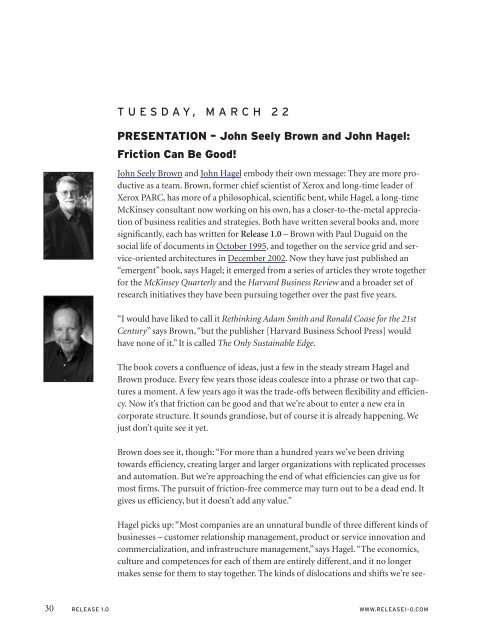The World Wide World: IT Ain't Just the Web ... - Cdn.oreilly.com
The World Wide World: IT Ain't Just the Web ... - Cdn.oreilly.com
The World Wide World: IT Ain't Just the Web ... - Cdn.oreilly.com
Create successful ePaper yourself
Turn your PDF publications into a flip-book with our unique Google optimized e-Paper software.
TUESDAY, MARCH 22<br />
PRESENTATION – John Seely Brown and John Hagel:<br />
Friction Can Be Good!<br />
John Seely Brown and John Hagel embody <strong>the</strong>ir own message: <strong>The</strong>y are more productive<br />
as a team. Brown, former chief scientist of Xerox and long-time leader of<br />
Xerox PARC, has more of a philosophical, scientific bent, while Hagel, a long-time<br />
McKinsey consultant now working on his own, has a closer-to-<strong>the</strong>-metal appreciation<br />
of business realities and strategies. Both have written several books and, more<br />
significantly, each has written for Release 1.0 – Brown with Paul Duguid on <strong>the</strong><br />
social life of documents in October 1995, and toge<strong>the</strong>r on <strong>the</strong> service grid and service-oriented<br />
architectures in December 2002. Now <strong>the</strong>y have just published an<br />
“emergent” book, says Hagel; it emerged from a series of articles <strong>the</strong>y wrote toge<strong>the</strong>r<br />
for <strong>the</strong> McKinsey Quarterly and <strong>the</strong> Harvard Business Review and a broader set of<br />
research initiatives <strong>the</strong>y have been pursuing toge<strong>the</strong>r over <strong>the</strong> past five years.<br />
“I would have liked to call it Rethinking Adam Smith and Ronald Coase for <strong>the</strong> 21st<br />
Century” says Brown, “but <strong>the</strong> publisher [Harvard Business School Press] would<br />
have none of it.” It is called <strong>The</strong> Only Sustainable Edge.<br />
<strong>The</strong> book covers a confluence of ideas, just a few in <strong>the</strong> steady stream Hagel and<br />
Brown produce. Every few years those ideas coalesce into a phrase or two that captures<br />
a moment. A few years ago it was <strong>the</strong> trade-offs between flexibility and efficiency.<br />
Now it’s that friction can be good and that we’re about to enter a new era in<br />
corporate structure. It sounds grandiose, but of course it is already happening. We<br />
just don’t quite see it yet.<br />
Brown does see it, though: “For more than a hundred years we’ve been driving<br />
towards efficiency, creating larger and larger organizations with replicated processes<br />
and automation. But we’re approaching <strong>the</strong> end of what efficiencies can give us for<br />
most firms. <strong>The</strong> pursuit of friction-free <strong>com</strong>merce may turn out to be a dead end. It<br />
gives us efficiency, but it doesn’t add any value.”<br />
Hagel picks up: “Most <strong>com</strong>panies are an unnatural bundle of three different kinds of<br />
businesses – customer relationship management, product or service innovation and<br />
<strong>com</strong>mercialization, and infrastructure management,” says Hagel. “<strong>The</strong> economics,<br />
culture and <strong>com</strong>petences for each of <strong>the</strong>m are entirely different, and it no longer<br />
makes sense for <strong>the</strong>m to stay toge<strong>the</strong>r. <strong>The</strong> kinds of dislocations and shifts we’re see-<br />
30 RELEASE 1.0 WWW.RELEASE1-0.COM
















